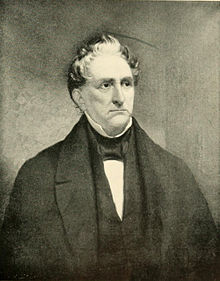Henry W. Edwards
| Henry Waggaman Edwards | |
|---|---|
 |
|
| 27th Governor of Connecticut | |
|
In office May 1, 1833 – May 7, 1834 |
|
| Lieutenant | Ebenezer Stoddard |
| Preceded by | John S. Peters |
| Succeeded by | Samuel A. Foot |
|
In office May 6, 1835 – May 2, 1838 |
|
| Lieutenant | Ebenezer Stoddard |
| Preceded by | Samuel A. Foot |
| Succeeded by | William W. Ellsworth |
|
United States Senator from Connecticut |
|
|
In office October 8, 1823 – March 4, 1827 |
|
| Preceded by | Elijah Boardman |
| Succeeded by | Samuel A. Foot |
| Member of the U.S. House of Representatives from Connecticut's At-large district |
|
|
In office March 4, 1819 – October 8, 1823 |
|
| Preceded by | Sylvester Gilbert |
| Succeeded by | Noyes Barber |
| Member of the Connecticut Senate | |
|
In office 1828-1829 |
|
| Personal details | |
| Born | October 1779 New Haven, Connecticut |
| Died | July 22, 1847 (aged 67) New Haven, Connecticut |
| Political party | Democratic |
| Spouse(s) | Lydia Miller |
| Alma mater | Princeton, Litchfield Law School |
| Profession | lawyer, politician |
Henry Waggaman Edwards (October 1779 – July 22, 1847) was an American lawyer, a Democrat, and the 27th and 29th Governor of the U.S. state of Connecticut.
Edwards was born in New Haven, Connecticut, the son of Pierpont Edwards and Frances Ogden. He graduated from Princeton University in 1797, and earned a law degree from the Litchfield Law School. He married Lydia Miller on October 4, 1801, and they had seven children.
Edwards became a lawyer, was active in Democratic politics, and was the United States Representative from Connecticut at-large from 1819 to 1823. He was appointed to fill the vacancy caused by the death of Elijah Boardman as a United States Senator and served from Connecticut from 1823 to 1827. He served as a member of Connecticut Senate at-large from 1828 to 1829. member of Connecticut state house of representatives from New Haven, in 1830, and the Speaker of the Connecticut House of Representatives in 1830. He was elected Lieutenant Governor of Connecticut in 1832, but was deprived of the office by a divided Assembly.
Elected in 1833, Edwards served as Governor of Connecticut from May 1, 1833 to May 7, 1834. Unsuccessful in his bid for the office in 1834, He was elected continuously and served again from May 6, 1835 to May 2, 1838. During his tenure, a discriminatory education law was enacted, the railroad expanded, and the state funded a geological survey in 1835. When he did not win the Democratic party's nomination in 1838, he retired from public service.
...
Wikipedia
